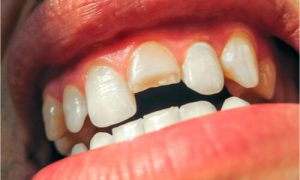Did you know that tooth fractures are actually quite common? Research shows that around 25% of all adults in the world have suffered a tooth fracture at some point in their lives. While most fractures are minor and don’t cause any problems, it’s important to be aware of the symptoms of a more serious fracture so that you can get treatment as soon as possible. This blog post will discuss the symptoms of a tooth fracture and what you need to do if you think you may have one.
- What can cause a tooth to fracture?
- What are tooth fracture symptoms?
- How is a tooth fracture treated?
- What are the risks of not treating a tooth fracture?
- How can you prevent tooth fractures from happening?
What can cause a tooth to fracture?
Teeth can break due to a variety of factors. A comprehensive dental history will make it easier for the dentist to determine what caused the tiny cracks in your tooth.
The following are some of the causes of a broken tooth:
- biting down on a piece of food too hard
- excessive tooth grinding
- bodily harm or physical injury
- age, as part of the tooth’s wear-and-tear
- a huge existing filling may be weakening the remaining tooth structure
- A quick temperature shift might also cause a tooth to break. This might happen, for example, if a person burns their mouth while drinking tea and then drinks a glass of cold water to relieve the pain.
What are tooth fracture symptoms?
A fractured tooth might not always create symptoms. People frequently have fractured teeth without recognising them. Some cracks are not dangerous and may not require treatment.
However, if a person experiences any of the following symptoms, they may have a more extensive sort of crack that need dental treatment:
- pain during eating, especially when chewing or biting
- swelling gums in the area of the cracked tooth
- teeth that have grown abruptly sensitive to sweetness
- teeth that have become sensitive to hot or cold meals
- an ache that comes and goes
- soreness around the teeth and gums from unknown cause
Types of Tooth Fracture
Tooth cracks are more prevalent in adults over the age of 40, and women are more likely than males to acquire them.
The length, depth, and position of cracks on the tooth can vary.
Craze lines are the tiniest fractures that form within the tooth enamel. A frenzy line is unlikely to be seen, and no treatment is required until it produces symptoms.
Other sorts of tooth fractures are as follows:
Oblique supragingival fractures. These are limited to the crown and do not extend beyond the gum line. As a consequence, they are typically not very painful.
Oblique subgingival cracks. These might be uncomfortable because they extend below the gum line. Treatment is required to reveal the crown and repair the tooth.
Split tooth. The tooth is split in two by this fracture. A dentist will most likely salvage only one component, which will be repaired with a crown. A person may also require root canal therapy.
Oblique root cracks. These fissures do not generally show on the tooth’s surface. The injury happens behind the gum line, most typically beneath the jawbone. Tooth extraction is sometimes the sole option for treating this sort of break.
Fractured cusp. This happens when a component of a tooth’s chewing surface breaks. A cracked cusp is most prevalent in the vicinity of a dental filling.
Vertical root fracture. This form of fracture starts at the tooth’s root and progresses to the crown. It may range in length, but the tooth will have to be removed because of the pain.
How is a tooth fracture treated?
The optimum treatment is determined by the fracture’s location and the extent of the crack.
If a crack is small and causes no discomfort, no treatment is usually required.
Cracked tooth treatments include:
- gluing a chipped or fractured piece of a tooth
- tooth bonding, the technique of mending a fissure with plastic resin.
- using a dental filling
- placing a dental crown, a covering that completely seals the damaged tooth
- covering the tooth with dental veneers to hide the crack
- in worst cases where the pulp is exposed because of the fracture, root canal therapy is required.
Root canal treatment may be required in the most difficult situations when a break has pierced the tooth’s pulp, like vertical root fractures. If a tooth is seriously damaged, a dentist may recommend removing it entirely.
When a filling on a tooth would crack, a dentist may need to remove the filling to inspect the problem more carefully.
Cracked teeth can lead to difficulties, especially if left untreated. An infection, for example, might arise.
Infection symptoms include:
- increasing ache
- gingival swelling
- heightened sensitivity to hot and cold
- bad breath
- sore neck glands
In an infection, pus may need to be drained, and antibiotic medications may be required.
What are the risks of not treating a tooth fracture?
A broken tooth can lead to a serious infection or dental abscess. A dental abscess is a collection of pus that forms below an infected tooth.
The risks of not treating a tooth fracture can include:
- Tooth decay
- Tooth loss
- Gum disease
- Infection
How can you prevent tooth fractures from happening?
You can’t prevent every tooth fracture. But you can reduce the risk of cracked tooth syndrome with good dental practices:
- Avoid chewing hard foods or ice.
- Stop unhealthy habits that can fracture your teeth, like biting on pens or grinding teeth at night.
- Practice good teeth and gum care.
- Wear a mouthguard made by your dentist if you play sports or grind your teeth at night.
- See your dentist regularly.
Outlook
A cracked tooth is a common experience for many. A variety of procedures are available to save the tooth and your appearance.
While a crack can be repaired, a cracked tooth will never be 100 percent healed, unlike a broken bone might be. But prompt treatment offers the best chance of saving your tooth and preventing infection and further damage. And while your mouth may be sore after the treatment, the pain should subside in a few days.
Good dental hygiene, avoiding hard foods, and wearing a mouth guard if you grind your teeth or play contact sports will go far in protecting your smile.
References:
https://www.medicalnewstoday.com/articles/322015
https://my.clevelandclinic.org/health/diseases/21628-fractured-tooth-cracked-tooth
https://www.healthline.com/health/cracked-tooth
https://www.aae.org/patients/dental-symptoms/cracked-teeth/
https://www.webmd.com/oral-health/guide/repairing-a-chipped-or-broken-tooth




